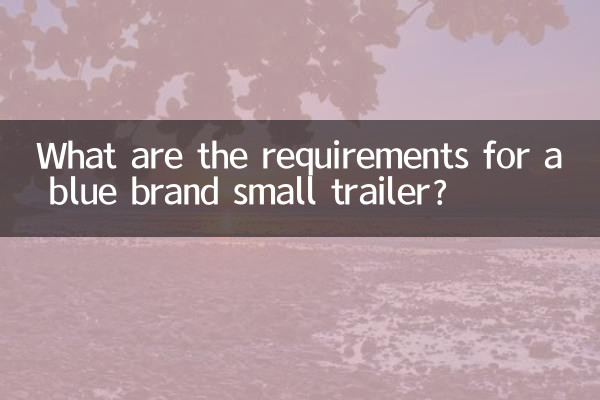What are the requirements for a blue brand small trailer?
In recent years, with the increase in logistics transportation and individual transportation needs, blue brand small trailers have received widespread attention due to their flexibility and economy. This article will combine hot topics and hot content in the past 10 days to analyze in detail the relevant requirements for blue-brand small trailers, including vehicle standards, driving qualifications, usage restrictions, etc., to help users fully understand the compliant use of blue-brand small trailers.
1. Definition and classification of blue brand small trailers

A blue plate trailer refers to a small trailer vehicle with a blue license plate, usually used for light cargo transportation or household use. According to use and structure, it can be divided into the following two categories:
| Type | Purpose | Maximum total mass |
|---|---|---|
| cargo trailer | Transporting light cargo | ≤4.5 tons |
| home trailer | Camping, moving furniture, etc. | ≤3.5 tons |
2. Technical requirements for blue brand small trailers
According to the "Road Traffic Safety Law" and relevant national standards, blue brand small trailers need to meet the following technical requirements:
| Project | Specific requirements |
|---|---|
| vehicle size | Length ≤ 6 meters, width ≤ 2.5 meters, height ≤ 4 meters |
| lighting system | Must be equipped with position lights, brake lights, turn signals |
| Braking system | An independent braking device is required |
| Reflective logo | Reflective strips need to be pasted on both sides of the car body |
3. Driving qualifications and license requirements
Driving a blue plate tow truck must meet the following conditions:
| Project | request |
|---|---|
| driver's license | C1 or C2 driving license (total trailer mass ≤ 4.5 tons) |
| vehicle license plate | A separate application for a trailer license (blue plate) is required |
| insurance | Compulsory traffic insurance and third party liability insurance are required |
4. Usage restrictions and precautions
1.load limit: The load capacity of a blue-branded small trailer shall not exceed the approved total mass. Overloading will result in fines.
2.highway driving: In some areas, small trailers with blue plates are prohibited from entering the highway. Please check local regulations in advance.
3.Regular inspection: Trailers need to undergo annual inspections in accordance with regulations to ensure vehicle safety.
4.Parking requirements: Trailers are not allowed to be parked randomly and must be parked in designated areas.
5. Recent hot topics
In the past 10 days, hot discussions about blue brand trailers have mainly focused on the following aspects:
1.The rise of new energy trailers: Some companies have launched electric blue-brand small trailers, which are environmentally friendly and low-cost.
2.policy adjustment: Many places have begun to strengthen the supervision of blue-label small trailers, and strictly investigate overloading and illegal modifications.
3.Growing user demand: With the popularity of camping and road trips, sales of home trailers have increased significantly.
6. Summary
As an economical and practical means of transportation, the blue-brand small trailer must strictly comply with vehicle technology, driving qualifications, and legal and regulatory requirements when used. Users should regularly check the condition of their vehicles to avoid overloading or illegal driving to ensure safe travel. At the same time, paying attention to policy changes and industry trends will help to better utilize blue brand small trailers to meet transportation needs.

check the details

check the details